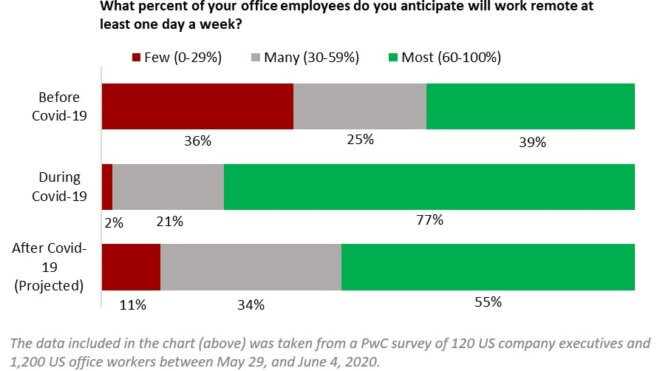Part 2: Combating the Challenges
Five months ago, we realized that Carleton McKenna & Co, like so many other businesses, was about to undergo an unplanned, immediate and imperative shift to remote work. Without knowing the extent of this endeavor, we scrambled to set up at-home offices, pick up college kids, overstock our cabinets with cleaning products, and in some cases, adopt kittens to keep us company. While we have worked extremely hard these last five months—both adapting and learning how to properly collaborate and communicate as a fully-distributed team—we can still appreciate the challenges many companies face in this new-age, pandemic-altered, work environment.
Combating the Challenges of Fully Distributed Workforces
Various work-from-home strategies have helped individuals and organizations find success and satisfaction during the COVID-19 pandemic-driven shift to fully-remote work, but the reality is that there is no one-size-fits-all solution. While many are enjoying this new, no-commute, exclusively virtual work experience, others are suffering from endless ‘Zoom fatigue’ and home distractions. While productivity is increasing for some employees with diverse job functions, others are experiencing a meaningful decline in output. Certain forms of virtual collaboration are working dependably and smoothly, while others are proving to be unreliable. Some employees have ‘remote mentors’ and are able to participate in casual, unplanned and important conversations with colleagues, while others are missing out on key, often casual and unplanned workplace interactions.
In Part 1 of Carleton McKenna’s series, “Fully Distributed” Workforces — A Megatrend of the Future?, we discussed how COVID-19 was changing the virtual work environment and what future opportunities may be in store for fully-distributed businesses and their employees. Now, two months deeper into a pandemic-altered business world, Carleton McKenna will discuss some of the challenges facing these workforces and how organizations are finding innovative ways to combat these issues—both through operational change and strategic investment. As this large-scale, work-from-home, global experiment signals a more permanent shift, organizations must rise up to the challenge to stay relevant in the future.
What is your biggest struggle with working remotely?
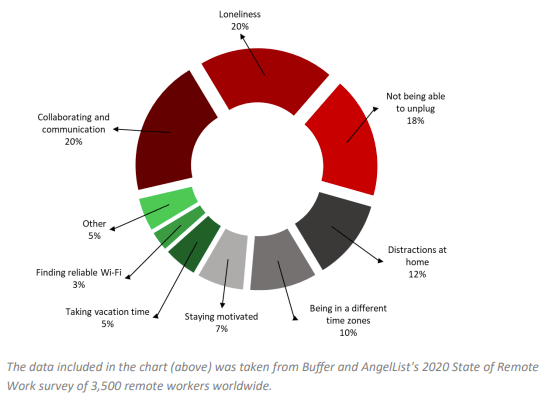
The Communication Challenge—how to we work together, when we are in fact, alone?
In any organization, geographically dispersed or centralized, teams need to be able to communicate effectively. Decision-making and operational processes must be established and feasible for all team members. Centralized teams obviously have a big advantage from this perspective, as problem solving can be done with everyone in one location. When teams are fully-distributed, decision-making can become asychronous if each step of the decision-making process is not well understood or properly dele
In any organization, geographically dispersed or centralized, teams need to be able to communicate effectively. Decision-making and operational processes must be established and feasible for all team members. Centralized teams obviously have a big advantage from this perspective, as problem solving can be done with everyone in one location. When teams are fully-distributed, decision making can become asynchronous if each step of the decision-making process is not well understood or properly delegated and team members are not autonomous.
When analyzing successful methods for creating strong and organized virtual decision making, it is helpful to look to ‘born digital’ companies, as these organizations have only existed with frameworks and processes for dealing with remote teams. Zapier, for example, uses a framework called DACI—driver, approver, consulter and informed. Anyone involved in a decision will play one of four roles: (i) the driver of the work/data collector; (ii) the approver (gives the go ahead); (iii) the consultant/expert; and (iv) the informed individual/department who needs to know the outcome. Knowing decision roles upfront speeds up team interactions and avoids ambiguities that can delay processes.
Furthermore, Zapier believes transparency to be critical in a distributed work environment. The company uses an internally built digital platform that helps to surface important conversations that may otherwise get lost in email, chat or phone communications. As COVID-19 causes more companies to adopt a remote (or partially remote) work model, digital communication tools and platforms are in high demand.
Examples of workforce communication and collaboration-based acquisitions in Summer 2020 (June-August):
Date
Target
Description
Acquirer(s)
EV ($M)
8/4

Leading provider of secure online collaboration and
document sharing solutions for boards, committees and
leadership teams.


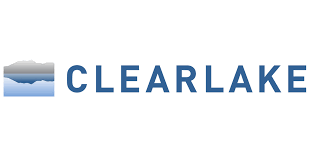
$4,000
7/15

Employee communication and engagement platform
that measurably reaches, aligns and mobilizes workers
in a personalized way.

$100
7/14

Cloud native communications software offering
application servers, user interface technologies,
gateways, DSP-based media platforms and network
management.

Undisclosed
Sources: The Wall Street Journal, Harvard Business Review, Pitchbook
The Productivity Challenge—can work get done in a more flexible, relaxed setting?
According to OWL Labs 2019 State of Remote Work report, remote employee managers were historically most concerned about reduced employee productivity and reduced employee focus—82% of manager respondents selected these categories as their biggest challenges and concerns in 2019. However, as the COVID-19 pandemic has sent nearly 62% of employed Americans home to work during the crisis (Gallup), these views of productivity may be changing.
Before the pandemic, the conventional
thought was that offices were critical to
productivity, culture and winning the ‘talent
war’. Companies competed intensely for prime office space in major urban centers around the world, and many focused on solutions that were expected to promote collaboration, such as open concept office layouts. Now that the COVID-19 pandemic has forced many office employees into several months of at-home work, these office perceptions are changing.
Top six concerns of managers of remote teams
(2019 Pre-COVID-19)
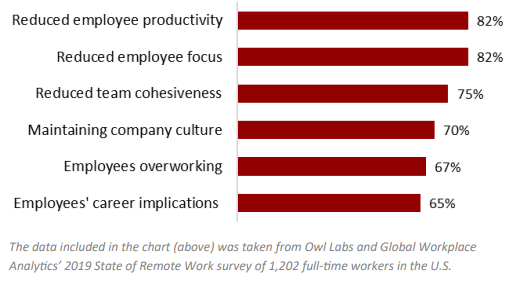
In fact, according to a June 2020 PwC survey, most office workers now want some option for remote work, with 72% of employees reporting that they would like to work away from the office for at least two days a week.
Nearly 55% of company executives are in agreement with this trend and expect to extend work-from home options for most of their office workers to at least one day of the week post-COVID-19. Why are executives so open to this remote work trend, particularly when the physical office has always been seen as critical to innovation and creativity? Like all evolutions, perhaps these executives understand that it’s time for the next iteration of the ‘physical office’.
As demonstrated in the chart to the right, executives are more likely to report that employees have become more productive (44%) while working at home during the crisis. Employees are less sure of this theme, with only 28% considering themselves more productive. Noteworthy is that both employees and employers agree on the two top-requirements for being able to work productively at home:
Has productivity changed during COVID-19 shelter at home?
(Employees vs. Employers)

01. Greater flexibility in work hours: moving work hours away from a traditional eight-hour work block and provide some flexibility as to when work can be done.
02. Better hardware and equipment: providing laptops, monitors, printers and chairs, as millions of people were not set up for a successful remote work environment prior to the pandemic.
According to a CompTIA (Computing Technology Industry Association) survey of over 200 U.S. tech firms, more than 80% of enterprise-technology providers responded that corporate customers in April, 2020 were shopping for additional communications, collaboration and remote-work tools. As companies across the economy consider a more permanent shift to remote work in the aftermath of COVID-19, we can anticipate a surge in acquisitions for startups developing a variety of collaboration, access management and other virtual business tools aimed at supporting a distributed workforce.
Many corporate executives are convinced that reliance on remote worker technology will be ongoing, and are quickly making the necessary strategic moves to give their organizations a leg up on competition. Select workforce communication and collaboration-based acquisitions completed by large tech companies over the last few months are included in the chart above.
Although employees and executives may agree on the top requirements for increasing productivity, research suggests that the number of employers who plan to make these policy or operational changes is only 35% – 57%. Employees are signaling they need support and employers have the opportunity to make remote work effective by addressing these concerns. While those needs listed in the chart (below) are a good place to start, all personal and organizational circumstances are different, and employers should directly ask employees about their specific needs and preferences in order to maintain ‘office-levels’ of productivity or greater.

The Culture Challenge—how do we provide a fulfilling employee experience in a remote work setting?
Is it possible that the post pandemic workplace may no longer be a “place” but potentially a list of tasks and activities that can be performed in any location and on any device over the internet? As we experienced during the COVID-19 pandemic, this type of dispersed work model can strongly compromise flows of communication and relationship development. In particular, more casual conversations and bonding through impromptu in-person meetings or joint coffee breaks are less natural. In fact, according to a survey by Clutch amid the pandemic:

Without normal office conversation, companies need to find new ways to build and/or maintain organizational comradery and trusting relationships. Although offices are adopting tools to communicate virtually, such as Zoom, Microsoft Teams and Google Hangouts, socialization is still suffering. So how do we create social cohesion and involvement in a remote work setting? Companies at the forefront of digital transformation are encouraging businesses to look at a holistic digital workplace strategy—not only focusing on the ways people work, the tools they need and the skills they need to develop, but also at the impact they wish to have on company culture.
While many organizations have done well in addressing employees’ immediate safety and stability concerns, a full return requires organization wide commitment to a broader range of needs—including drivers of employee engagement, well-being and effectiveness.
Sources: PwC, McKinsey & Company, PR Newswire
Employee needs by experience factor and resulting effect on employee engagement, well-being and effectiveness:
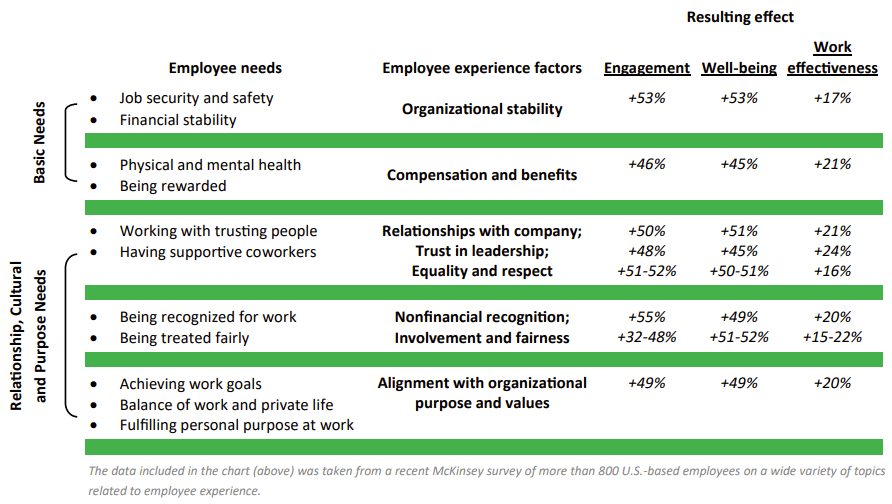
Company culture begins with fulfilling basic needs (i.e. job security and financial stability). However, personal needs for trusting relationships, social inclusion and individual purpose all have a disproportionate impact on employee engagement, well-being, satisfaction and as a result, overall work effectiveness (McKinsey). As organizations solve for employees’ basic health and wellness safety with work from-home options, they must also continue to meet employees’ relationship, cultural and purpose needs through the new modes of digital and distanced communications. While fun chat channels, after hour virtual socials, and social distanced company retreats work for some, we circle back to the “there is no one size-fits-all solution” theme.
Organizations should take a personalized approach to fostering culture. In establishing new mindsets and behaviors (such as adapting to a new virtual-working model), it is important to engage employees in a continual two way dialogue that takes into consideration (i) their specific needs, (ii) allows them to configure their own journeys, (iii) delivers personalized coaching, and (iv) provides them with a forum to share best practices with others who may share similar challenges.
Leaders of large middle market companies can use a combination of science, technology, data and analytics to segment employees (like they would customers) and tailor interventions in personalized and meaningful ways. Employers can use publicly available data along with internal tools (open-listening channels, pulse surveys and other advanced analytics) to understand the diverse set of challenges that individuals and teams are facing and identify the best ways of supporting them. Noteworthy is the recent trend of capital investments in companies offering digital solutions focused on employee engagement.
Sources: PwC, McKinsey & Company
Examples of capital investments in digital employee engagement solutions in Summer 2020
Date
Company
Description
Investment Size ($M)
Post-Money Valuation ($M)
8/18

SaaS-based employee engagement and talent management platform
creating data-driven people strategies backed by insights and
analytics, enabling employees to be seen, heard and valued.
$3.5
NA
6/23

Online platform combining employee recognition with company goals/values to increase employee engagement and enable business leaders to engage employees within changing workplace dynamics.
$122
$1,200
It is a natural tendency for leaders to focus on operations during challenging times, yet research shows that sustaining trust and acknowledging employee efforts are critical to maintaining employee effectiveness during a less stable economic environment (see chart under previous subheading).
Various technology solutions are being developed to maintain and even improve virtual organizational communication, collaboration and culture, requiring company leaders to understand the unique challenges and needs faced by their workforce. Leaders that provide employees with the necessary resources, tools and benefits to maintain communication and productivity will likely outperform in our new more-virtual working reality.
Further, leaders that are able to empower employees with (i) strong and trusting relationships, (ii) meaningful recognition, and (iii) a true sense of purpose aligned with organizational values will be able to thrive in this more distanced and distributed work environment.

